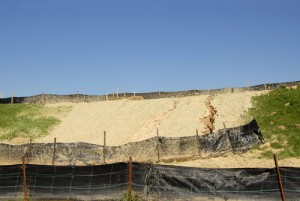Development and construction can lead to significantly increased erosion rates, which have many negative effects. Not only can erosion make slopes and embankments unstable, which directly impacts any structures recently built near them, but it also can result in destroyed ecosystems, degraded water supplies and increased flood hazards. This is why erosion control on construction sites is such a focus and a primary objective. There are four basic principles of erosion control and properly implementing all of them is the only way to ensure effectiveness.
- Erosion control measures
Your primary course of action is to keep the soil on your site in place. In order to do that, you need to limit vegetation removal when possible. You can also try to cover bare soils by seeding and covering with straw. Additional provisions are necessary when working in a sensitive habitat, or on a steep slope. Erosion control blankets are typically best applied on steep slopes and can be used to cover soil after seeding has taken place.
- Sediment control measures
Think of sediment control as a back-up, or secondary defense, to erosion control. Should the erosion control measures fail, sediment control measures are designed to capture eroding soil and keep it on site. This can be done be using straw rolls on slopes or at the bottom of slopes. Or, silt fences can be placed at the bottom of slopes, provided they don’t impact drainage. Gravel bags, particularly around drainage inlets are also commonly used. Finally, rocked driveways and entrances prevent soil and sediment from being tracked onto adjacent roads. Remember, none of these measures are meant to initially stop erosion. Rather, they’re intended to capture soil that has eluded erosion control measures before it can cause any damage.
- Runoff control measures
The primary enemy in erosion control is water. That means controlling stormwater, and keeping it away from bare soils, is essential to preventing soil erosion. Your first option will be to find a vegetated area that can withstand increased runoff. This can be done by diverting the runoff from any bare soils and newly disturbed areas. When dealing with a large concentration of water, it’s unwise to concentrate all of your runoff to one area. Find multiple locations for drainage and ensure your development won’t cause additional erosion after construction is completed. It’s also important to avoid fill slopes in favor of cut slopes for drainage. If that’s impossible, try breaking up drainage in order to create sheet flows over the slope. If you’re implementing pipe, conduits or channels for runoff, be sure to install energy dissipators such as a collection of rocks, which reduces flow velocity and helps prevent scour and downstream erosion.
- Maintenance
Because there’s typically no sure-thing in erosion control, it’s important to continually check on the measures you’ve put in place, particularly when it rains. You should be able to spot areas that may need additional reinforcement, or need a new plan all together. In order to help the ability of the erosion control measures, try to regularly clear out silt that has built up around silt fencing or drainage inlets.
At Maxwell Supply of Tulsa, we carry a variety of products that help you prevent erosion on your job site. Stop by and see us, or give us a call at 918-836-8606 to learn more.
